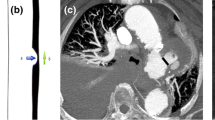Abstract
Objectives
To assess the efficacy of fine focal spot imaging in calcification beam-hardening artefact reduction and vessel clarity on CT abdominal angiography (CTAA).
Methods
Adult patients of any age and gender who presented for CTAA were included. Thirty-nine patients were examined with a standard focal spot size (SFSS) of 1 × 1 mm in the first 3 months while 31 consecutive patients were examined with a fine focal spot size (FFSS) of 1 × 0.5 mm in the following 3 months. Vessel clarity and calcification beam-hardening artefacts of the abdominal aorta, celiac axis, superior mesenteric artery, inferior mesenteric artery, renal arteries, and iliac arteries were assessed using a 5-point grading scale by two blinded radiologists randomly.
Results
Cohen’s Kappa test indicated that on average, there was substantial agreement among reviewers for vessel wall clarity and calcification artefact grading. Mann-Whitney test showed that there was a significant difference between the two groups, with FFSS performing significantly better for vessel clarity (U, 6481.50; p < 0.001; r, 0.73) and calcification artefact reduction (U, 1916; p < 0.001; r, 0.77).
Conclusion
Fine focus CT angiography produces images with better vessel wall clarity and less vessel calcification beam-hardening artefact.
Key Points
• Focal spot size affects the spatial resolution of a CT system.
• Fine focus CTAA produces images with improved vessel wall clarity.
• Fine focus CTAA is associated with fewer calcification beam-hardening artefacts.
• Fine focus CTAA may improve accuracy in assessment of luminal stenosis.








Similar content being viewed by others
References
Yu T, Zhu X, Tang L, Wang D, Saad N (2007) Review of CT angiography of aorta. Radiol Clin North Am 45(3):461–483
Ouwendijk R, Kock M, van Dijk L, van Sambeek M, Stijnen T, Hunink M (2006) Vessel wall calcifications at multi-detector row CT angiography in patients with peripheral arterial disease: effect on clinical utility and clinical predictors. Radiology 241(2):603–608
Ofer A, Nitecki S, Linn S et al (2003) Multidetector CT angiography of peripheral vascular disease: a prospective comparison with intraarterial digital subtraction angiography. AJR Am J Roentgenol 180(3):719–724
Dhawan AP (2010) Medical image analysis, 2nd edn. Wiley-IEEE Press, Hoboken
Haidekker MA (2013) Medical imaging technology, 1st edn. Springer, New York
Bushberg JT (2011) The essential physics of medical imaging, 3rd edn. Wolters Kluwer Health/Lippincott Williams & Wilkins, Philadelphia
Philips Healthcare (2011) Clinical confidence in action: Philips Ingenuity Core 128 specifications, brochure, Philips Healthcare, The Netherlands. Available via http://www.healthcare.philips.com/main/shared/assets/multimedia/imaging20/pdfs/NM_Ingenuity_Core_128_Specs.pdf. Accessed 26 Dec 2013
Nalawade YV (2009) Evaluation of breast calcifications. Indian J Radiol Imaging 19(4):282–286
Koutalonis M, Delis H, Spyrou G, Costaridou L, Tzanakos G, Panayiotakis G (2008) Monte Carlo studies on the influence of focal spot size and intensity distribution on spatial resolution in magnification mammography. Phys Med Biol 53(5):1369–1384
Seeram E (2008) Computed tomography : physical principles, clinical applications, and quality control, 3rd edn. Saunders/Elsevier, Edinburgh
Hendee W, Ritenour (2002) Medical imaging physics, 4th edn. Wiley-Liss, New York
Saia DA (2008) Radiography prep : program review and examination preparation, 5th edn. McGraw-Hill, New York
Tins B, Oxtoby J, Patel S (2001) Comparison of CT angiography with conventional arterial angiography in aortoiliac occlusive disease. Br J Radiol 74(879):219–225
Vlahos I, Chung R, Nair A, Morgan R (2012) Dual-energy CT: vascular applications. AJR Am Roentgenol 199(5 Suppl):S87–S97
Bozlar U, Ogur T, Norton P, Khaja M, All J, Hagspiel KD (2013) CT angiography of the upper extremity arterial system: part 1-anatomy, technique, and Use in trauma patients. AJR Am J Roentgenol 201(4):745–752
Meyer B, Werncke T, Hopfenmuller W, Raatschen H, Wolf K, Albrecht T (2008) Dual energy CT of peripheral arteries: effect of automatic bone and plaque removal on image quality and grading of stenosis. Eur J Radiol 68(3):414–422
van Straten M, Venema H, Streekstra G, Reekers J, den Heeten G, Grimbergen CA (2003) Removal of arterial wall calcifications in CT angiography by local subtraction. Med Phys 30(5):761–770
Thomas C, Korn A, Krauss B et al (2010) Automatic bone and plaque removal using dual energy CT for head and neck angiography: Feasibility and initial performance evaluation. Eur J Radiol 76(1):61–67
Acknowledgments
The scientific guarantor of this publication is A/Prof. Kenneth K Lau. The authors of this manuscript declare no relationships with any companies, whose products or services may be related to the subject matter of the article. The authors state that this work has not received any funding. Mr. Minh Huynh from RMIT University kindly provided statistical advice for this manuscript. This project was approved by the Human Research Ethics Low Risk Review Panel of Monash health. Written informed consent was not required for this study because it was waived by the Human Research Ethics Low Risk Review Panel of Monash health. Methodology: Prospective, observational study, performed at one institution.
Author information
Authors and Affiliations
Corresponding author
Rights and permissions
About this article
Cite this article
Oh, L.C.W., Lau, K.K., Devapalasundaram, A. et al. Efficacy of ‘fine’ focal spot imaging in CT abdominal angiography. Eur Radiol 24, 3010–3016 (2014). https://doi.org/10.1007/s00330-014-3368-6
Received:
Revised:
Accepted:
Published:
Issue Date:
DOI: https://doi.org/10.1007/s00330-014-3368-6




